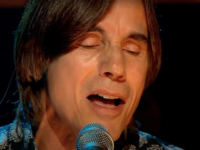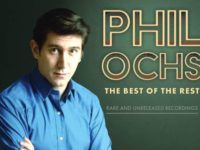Author and Rolling Stone reporter David Browne will appear at 2 p.m. on Saturday, May 10, at the Long Island Music and Entertainment Hall of Fame (97 Main St. in Stony Brook, N.Y.), to discuss his latest book: ‘Talkin’ Greenwich Village: The Heady Rise and Slow Fall of America’s Bohemian Music Capital.’
LIMEHOF Vice Chairman Tom Needham will interview Browne. Attendees can purchase copies of the book for the author to sign. The event is free for LIMEHOF members and there will be general admission tickets available for non-members.
Browne is the author of six books, including the critically acclaimed ‘Dream Brother: The Lives and Music of Jeff and Tim Buckley’ and ‘Fire and Rain: The Beatles, Simon and Garfunkel, James Taylor, CSNY and the Lost Story of 1970.’ He joins us to discuss his new book, folk music in general and the intersection of music and politics:
STEVE MATTEO: What was the inspiration to do a book on the Greenwich Village folk scene?
DAVID BROWNE: In 2019-20, I wrote a few stories for Rolling Stone, where I work, that literally brought me back to that place: one on Ramblin’ Jack Elliott, which involved a walking tour of the neighborhood, and one on the late singer-songwriter-actor David Blue, who was part of the [Bob] Dylan posse in the ’60s. Researching both stories reminded me of the years I spent living and seeing shows in the Village, starting during my time as an NYU student, and I also realized that no one had written a narrative history of that world. Given the recent interest in the Village in the ’60s in movies like Inside Llewyn Davis and the TV series The Marvelous Mrs. Maisel, it felt like the time had come for a book on such a once-vital and culturally important scene – which, of course, also covers jazz and rock ‘n’ roll during this period, the ‘’50s to the ’80s. And no, I had no idea back in 2020, when I started this project, that Timothy Chalamet would be playing Dylan in a movie set during this period!
STEVE MATTEO: How did your approach differ from your 1970 book which also covered multiple artists and to a similar degree in some cases musical scenes?
DAVID BROWNE: Talkin’ Greenwich Village shares some similarities with Fire and Rain in the way its leading characters, Simon and Garfunkel, CSNY, the Beatles and James Taylor, overlap throughout the book. But Talkin’ Greenwich Village is more a biography of a neighborhood, spanning decades – a type of book I’d never written before. In that regard, it was by far the most challenging book I’ve done in terms of maintaining throughlines and characters over the course of more than the 30 years I cover. There were many index cards scattered around the floor of my home!
STEVE MATTEO: Have you always been a fan of folk music?
DAVID BROWNE: When I was growing up in New Jersey, my two older sisters were big music fans and especially of the singer-songwriters of that time – the ’60s and ’70s. So, I heard a lot of Simon and Garfunkel, James Taylor, CSNY, Joni Mitchell, Cat Stevens, and such around the house and loved all of it. As I got older and embarked on my own career as a music journalist, I began digging deeper into the music that preceded them – snapping up many Folkways LPs, for instance – and also discovering many artists, like Leonard Cohen and the late Phil Ochs, whose records hadn’t been played around the house. So folk and acoustic music have always been a major part of my music diet.
STEVE MATTEO: Were you drawn more to the music or the scene?
DAVID BROWNE: Both, but the scene itself was the story to me: How, almost by happenstance, that compact neighborhood – from Broadway to the Hudson, from 14th Street to Houston – became a magnet for music outsiders, rebels and outcasts who opened clubs, made music there, reinvented themselves there, and saw it explode and then gradually collapse. Although a handful of clubs still remain, like the venerable Village Vanguard, the overall rise and fall of the Village scene to me is a metaphor for the rise and heyday of bohemianism in America.
STEVE MATTEO: It seems the last time there were any locale-based scenes in music was the Seattle grunge scene and rap coming from various locales like the Bronx, Queens, Compton, Los Angeles, etc. As someone once said, is the scene – or musical scenes – dead?
DAVID BROWNE: Music scenes never die; they just pop up when and where you least expect them to. I’m not sure anyone outside Compton or Seattle or Athens, Georgia, saw those music communities coming. Lately I’ve been hearing about a developing music scene in Ridgewood, Queens. And if so, I’d imagine it benefits from the economic factors that fostered scenes like the Village in the past – cheap rent, unconventional venues for live music that are also more affordable than those in the city.
STEVE MATTEO: Reading the book amidst the return of Trump added an interesting if unsettling extra perspective to the book. Can popular music still have an impact on politics, given the artists in music today?
DAVID BROWNE: I had a similar thought as I was wrapping up the book in early 2024. Talking with people about Dylan, Ochs and others in the ’60s scene reminded me of the way some of them, Ochs especially, would watch the evening news or read the newspaper and then write a song about a particularly jarring or compelling story about social justice or the war. And then put it on a record! Which, in turn, got me to thinking about how little we have seen of that type of topical songwriting in recent years. We’re starting to see more of that, bit by bit. I was just listening to the scathing “Make America Hate Again” by U.K. singer-songwriter Grace Petrie, from 2017. But it still feels as if protest songs haven’t quite returned to the public consciousness yet. Hopefully the events of the last few months will encourage more of this, and the ease with which a musician can post one of these songs online, such as Jesse Welles, might bring about the return of the protest song.
STEVE MATTEO: Was there anybody you wished you could have interviewed for the book but you didn’t for whatever reason? Did you try to get an interview with Bob Dylan?
DAVID BROWNE: Dylan was top of the list for sure, and I did put in an official request to speak with him for it. He rarely if ever conducts interviews for books like these, and he’d already written about his arrival in the Village and meeting characters like Dave Van Ronk in his own Chronicles. So, while his team was happy to pass along my request, I had a feeling it might not happen. Others who I was eager to interview, from songwriters Len Chandler and Patrick Sky to Night Owl owner Joe Marra, literally passed away as I was researching the book, and I was saddened that I didn’t get to speak with them for that reason. Their passings were another indication that history was being erased year by year.
STEVE MATTEO: Given all the music being reissued, particularly on vinyl how come we’re not seeing more folk music being reissued?
DAVID BROWNE: On Record Store Day last year, I was heartened to see a vinyl reissue of the first album by the Roches, whose music and lives I chronicle in the book. They were part of the last great wave of folk in the Village starting in the ’70s. As far as more reissues along those lines, I assume it’s market-driven and that labels don’t sense an opportunity to make a lot of money from repressing ’60s or ’70s releases folk releases.
STEVE MATTEO: Do you have any particular folk albums that are favorites? Are there any folk albums that you feel are grossly unknown or underappreciated?
DAVID BROWNE: At this point in time, I feel that description would apply to so many artists in my book, including Dave Van Ronk and Phil Ochs. Van Ronk’s albums like Folksinger (home of his version of “Cocaine”) and Sunday Street” – a later gem, especially for the title track – are valuable early introductions to the scene. Ochs’ Rehearsals for Retirement, written and recorded right after the disastrous ’68 Democratic convention, is one of the unheralded great albums of the ’60s – a middle ground between scruffy rock ‘n’ roll and his acoustic leanings, and between hope and much despair. Of the later crowd, Maggie and Terre Roche’s lovely Seductive Reasoning tends to be overlooked compared to the sister trio’s later work, singer-songwriter, is a lost gem.




